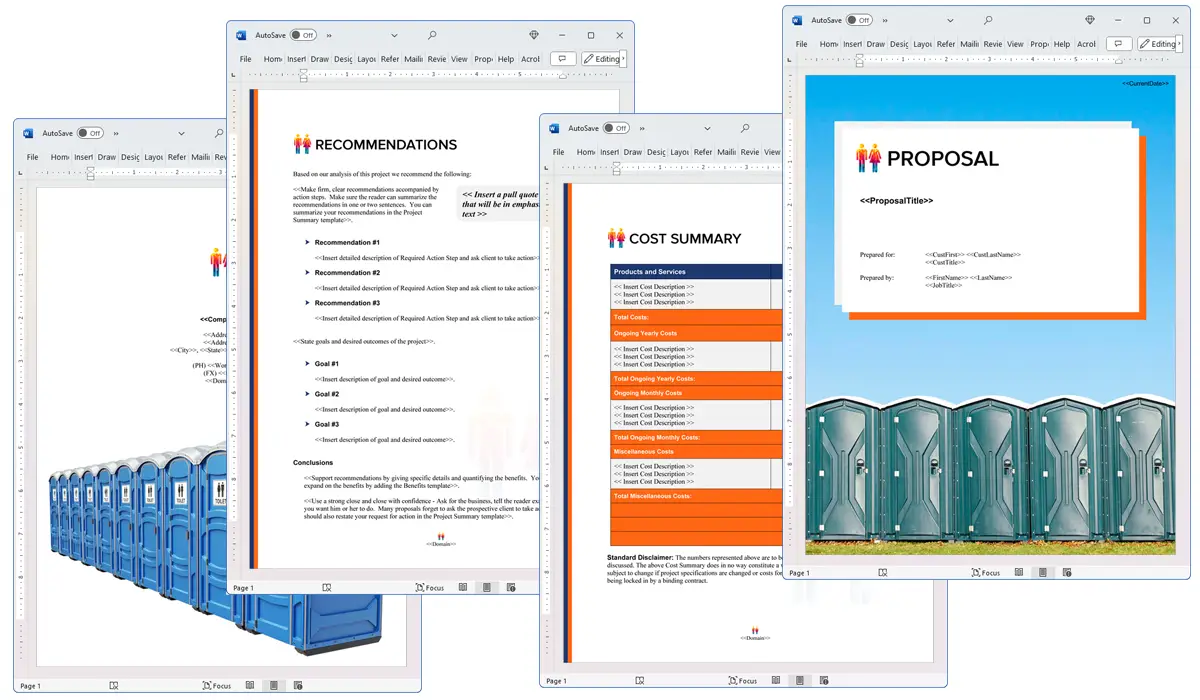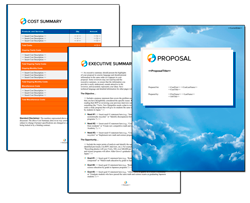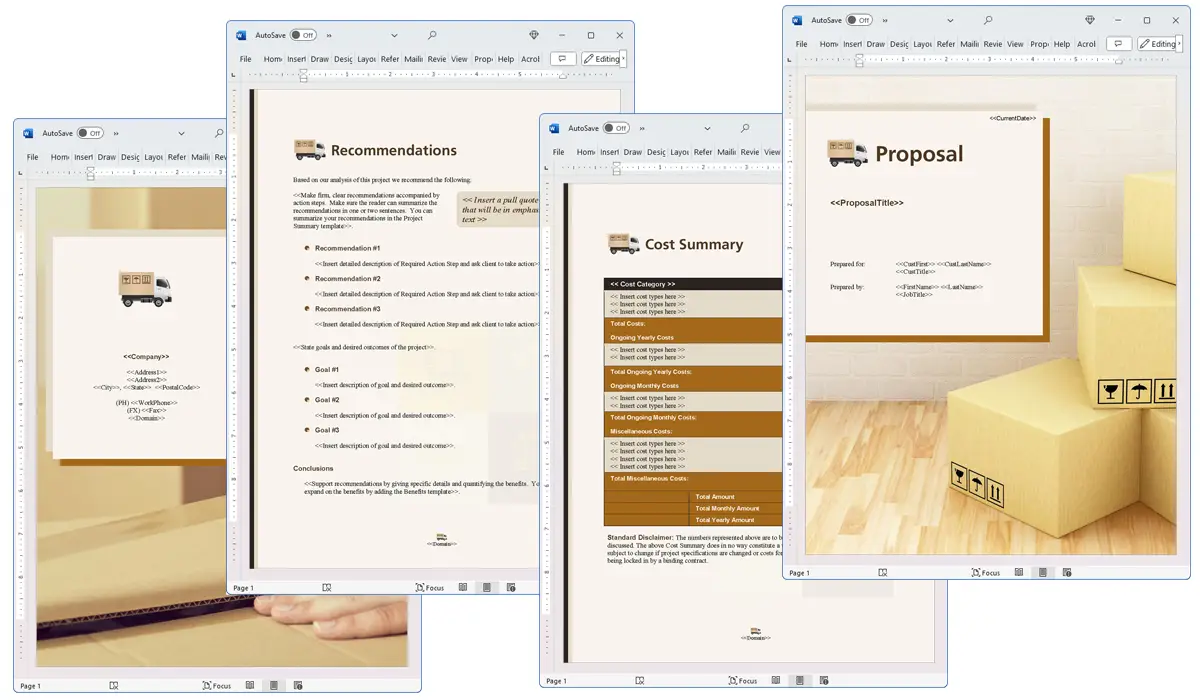What is the Scope chapter used for?
Proposal Kit Professional Bundle adds more design themes, all six Contract Packs,
a project management library, and Expert Edition software.

Illustration of Proposal Pack Sanitation #2
We include this Scope chapter template in every Proposal Pack, along with thousands more. You assemble this chapter with others in various combinations to create custom-tailored business proposals, plans, reports, and other documents. Proposal Packs apply custom visual designs to the templates, giving the final documents a consistent professional finish.
 DOWNLOADABLE, ONE-TIME COST, NO SUBSCRIPTION FEES
DOWNLOADABLE, ONE-TIME COST, NO SUBSCRIPTION FEES
Overview of the Scope Chapter
In the field of business proposals, clarity and precision are paramount. One of the important components of a proposal is the Scope chapter. This chapter plays an important role by outlining the extent and boundaries of a project. It ensures that all parties involved have a clear understanding of what the project entails, what is included, and importantly, what is not. This chapter sets the foundation for the project's success by aligning expectations and preventing misunderstandings.
How is the Scope Chapter Used?
The Scope chapter is used in a business proposal to provide a detailed description of the project's coverage. It helps in defining the parameters within which the project will operate. This chapter is crucial for delineating the services or products that will be delivered. It acts as a reference point throughout the project lifecycle, helping to keep the project on track and within the agreed boundaries. It's particularly useful in negotiations, as it can help all parties come to a common understanding of the project limits and deliverables.
What is Included in the Scope Chapter?
Typically, the Scope chapter includes several key elements:
- Project Boundaries: This defines what the project will cover and also highlights what is explicitly out of scope.
- Deliverables: A list of items that the provider will deliver by the end of the project.
- Services Provided: Details of the services that will be offered as part of the project.
- Objectives: The goals that the project aims to achieve, which should align with the overall business objectives.
- Exclusions: Clearly states what is not included in the project, helping to manage client expectations and prevent scope creep.
Use Case Examples for the Scope Chapter
The Scope chapter can be adapted to fit various scenarios. Here are some examples of how it might be used:
- Construction Proposal: Defining the physical boundaries of the construction site, the type of construction work to be done, and the materials that will be used.
- IT Project Proposal: Detailing the system requirements, software to be developed, and the functionalities that will be included or excluded.
- Marketing Campaign Proposal: Outlining the campaign reach, the platforms to be used, the target demographic, and the types of content to be created.
- Consulting Services Proposal: Specifying the business areas to be analyzed, the type of consulting services provided, and the extent of advice and documentation to be furnished.
- Event Planning Proposal: Describing the scale of the event, the services provided (like catering, security, and logistics), and the timeline of event planning and execution.
Key Takeaways
- Foundation for Clarity: The Scope chapter is important for clarifying the boundaries and deliverables of a project.
- Prevents Misunderstandings: By clearly defining what is included and what is excluded, it helps prevent misunderstandings and scope creep.
- Reference Point: Acts as a vital reference throughout the project lifecycle to keep all activities aligned with agreed objectives.
- Facilitates Negotiations: Useful during negotiations to help all parties understand the limits and capabilities of the project.
- Versatility: Adaptable to a wide range of industries and projects, making it a universally relevant part of any proposal.

Illustration of Proposal Pack Elegant #6
 What Our Clients Say
What Our Clients SayI have purchased this in the past (twice) for people I have worked for and I’m going to submit a proposal myself since I know how to do the work but Proposal Pack cuts a lot of the labor involved in "explaining" the process."
 4.7 stars, based on 849 reviews
4.7 stars, based on 849 reviewsAlternate Chapters
Related Chapters
Samples Using the Scope Chapter
Document Layouts Using the Scope Chapter
- Safety Strategy and Training Program Proposal
- Extensive Service Sales Proposal
- Standard Operating Procedure Document
- PhD Thesis Proposal
- Telecommunications Cellular Services Proposal
- ERP (Enterprise Resource Planning) System Proposal
- Smart Grid Pilot Project Proposal
- HOA Property Management Proposal
- Telecommunications RFP Response Proposal
- Big Data Project Proposal Template
- Records Management Survey Analysis

The Scope chapter and other chapters are integrated into a Word document as illustrated here in the Proposal Pack Transportation #9 design theme. There are hundreds of design themes available, and every design theme includes the Scope chapter template.
A proper business proposal will include multiple chapters. This chapter is just one of many you can build into your proposal. We include the complete fill-in-the-blank template in our Proposal Pack template collections. We also include a library of sample proposals illustrating how companies in different industries, both large and small, have written proposals using our Proposal Packs. This template will show you how to write the Scope.
We include a chapter library for you to build from based on your needs. All proposals are different and have different needs and goals. Pick the chapters from our collection and organize them as needed for your proposal.
Using the Proposal Pack template library, you can create any business proposal, report, study, plan, or document.
The Wizard software includes an AI Writer, which will write the content of this and any other chapter of your document. Use the AI Writer to do the heavy lifting, writing the first draft of your proposal or business document in minutes.
 Ian Lauder has been helping businesses write their proposals and contracts for two decades. Ian is the owner and founder of Proposal Kit, one of the original sources of business proposal and contract software products started in 1997.
Ian Lauder has been helping businesses write their proposals and contracts for two decades. Ian is the owner and founder of Proposal Kit, one of the original sources of business proposal and contract software products started in 1997.By Ian Lauder
 Published by Proposal Kit, Inc.
Published by Proposal Kit, Inc.


 Cart
Cart
 Facebook
Facebook YouTube
YouTube Bluesky
Bluesky Search Site
Search Site